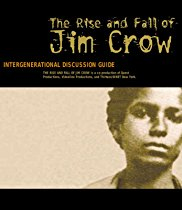The Rise and Fall of Jim Crow
Programs 1 & 2 - April 18
Programs 3 & 4 - April 25 <Read More>
The Rise and Fall of Jim Crow offers the first comprehensive look at race relations in America between the Civil War and the Civil Rights Movement. This definitive four-part series documents a brutal and oppressive era rooted in the growing refusal of many Southern states to grant slaves freed in the Civil War equal rights with whites. A life of crushing limitation for Southern Blacks, defined by legal segregation known as "Jim Crow" - after a minstrel routine in which whites painted their faces black - shaped the social, political and legal history of the period. In 1954, with the Supreme Court decision in Brown vs. Board of Education, the Jim Crow laws and way of life began to fall.
The story of the struggle during Jim Crow is told through the eyes of those who experienced it. Some are historical figures such as W.E.B. Du Bois, Booker T. Washington, Ida B. Wells and Walter White. Others are everyday local heroes like William Holtzclaw, Charlotte Hawkins Brown, Ned Cobb, "Pap" Singleton and Barbara Johns.
These screenings are cosponsored by Antaeus Theatre for its production of Nambi Kelley’s play Native son (based on the novel by Richard Wright).
 Program One: Promises Betrayed (1865 - 1896) (2002; 56 min)
Program One: Promises Betrayed (1865 - 1896) (2002; 56 min)
Story by Richard Wormser; Telescript by Bill Jersey; Produced by Sam Pollard; Directed by Bill Jersey
How did Jim Crow begin? As Reconstruction ended, African Americans' efforts to assert their constitutional rights began to be repressed at every turn, betraying the promises of Emancipation. Southern whites were embolden by the North's withdrawal of support for Black access to land, civil and economic rights, and due process in law and politics. Whites passed laws that segregated, divested and disfranchised African-Americans -- laws that were enforced with violence and terror. This episode recounts the Black response by documenting the work of such leaders as anti-lynching crusader Ida B. Wells and the emergence of Booker T. Washington as a national figure.
 Program Two: Fighting Back (1896 - 1917) (2002; 56 min)
Program Two: Fighting Back (1896 - 1917) (2002; 56 min)
Written, Produced and Directed by Richard Wormser
Episode two illustrates the early rise of a successful Black middle class and the determination of white supremacists to destroy fledgling Black political power. The growing oppression had a profound effect on a professor at Atlanta University, W.E.B. Du Bois, and a teenage mail carrier named Walter White. Both would become leaders of a newly founded organization to fight Jim Crow: the National Association for the Advancement of Colored People. The episode ends with the violence at home giving way to warfare abroad as thousands of Black Americans depart for battle in World War I.